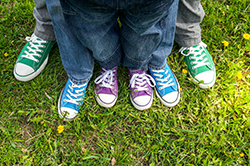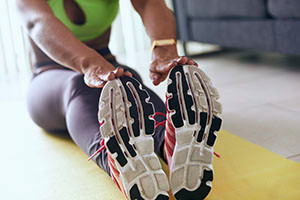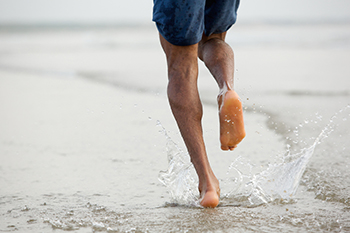 The feet are a complex part of the body that contains 25% of our bones. Because the average 50-year-old has walked 75,000 miles, it is important to keep the feet strong and healthy to prevent pain and diseases from impacting them. Common skin-related issues on the feet include fungal nail infections, corns, calluses, warts, ingrown toenails and athlete’s foot. Common muscle, tendon and joint problems include hammertoe, heel spurs, plantar fasciitis, bunions and arthritis. In order to prevent these issues, proper foot care is important. Regularly washing the feet, wearing clean socks, and making sure your feet are dry are key steps to helping prevent skin-related issues. Wearing comfortable shoes that fit correctly, stretching and massaging the feet, and moving around after sitting for long periods of time are also important in reducing the risk of foot problems. The biggest key to foot health, however, is knowing when to see a podiatrist. If your foot pain is inhibiting your ability to walk and function, or you are diabetic and notice new issues with your feet, it is important to seek the care of a podiatrist.
The feet are a complex part of the body that contains 25% of our bones. Because the average 50-year-old has walked 75,000 miles, it is important to keep the feet strong and healthy to prevent pain and diseases from impacting them. Common skin-related issues on the feet include fungal nail infections, corns, calluses, warts, ingrown toenails and athlete’s foot. Common muscle, tendon and joint problems include hammertoe, heel spurs, plantar fasciitis, bunions and arthritis. In order to prevent these issues, proper foot care is important. Regularly washing the feet, wearing clean socks, and making sure your feet are dry are key steps to helping prevent skin-related issues. Wearing comfortable shoes that fit correctly, stretching and massaging the feet, and moving around after sitting for long periods of time are also important in reducing the risk of foot problems. The biggest key to foot health, however, is knowing when to see a podiatrist. If your foot pain is inhibiting your ability to walk and function, or you are diabetic and notice new issues with your feet, it is important to seek the care of a podiatrist.
Everyday foot care is very important to prevent infection and other foot ailments. If you need your feet checked, contact Brent Harwood, DPM from Southeast Podiatry. Our doctor can provide the care you need to keep you pain-free and on your feet.
Everyday Foot Care
Often, people take care of their bodies, face and hair more so than they do for their feet. But the feet are a very important aspect of our bodies, and one that we should pay more attention to. Without our feet, we would not be able to perform most daily tasks.
It is best to check your feet regularly to make sure there are no new bruises or cuts that you may not have noticed before. For dry feet, moisturizer can easily be a remedy and can be applied as often as necessary to the affected areas. Wearing shoes that fit well can also help you maintain good foot health, as well as making it easier to walk and do daily activities without the stress or pain of ill-fitting shoes, high heels, or even flip flops. Wearing clean socks with closed shoes is important to ensure that sweat and bacteria do not accumulate within the shoe. Clean socks help to prevent Athlete’s foot, fungi problems, bad odors, and can absorb sweat.
If you have any questions please feel free to contact one of our offices located in Fairhope, Brewton, and Atmore, AL . We offer the newest diagnostic and treatment technologies for all your foot care needs.
Read more about Everyday Foot Care Implementing methods that can help to prevent running injuries is crucial to thoroughly enjoying the sport of running or jogging. Good habits can consist of warming up and cooling down before and after running, and it is beneficial to wear shoes that fit correctly. Additionally, it helps to gradually increase speed and mileage, as this can build endurance over time. Professional runners state it is best to increase the miles that are run by 10 percent or less per week. If you would like more information about foot conditions that can occur from running, running injuries, and how to prevent them, please consult with a podiatrist.
Implementing methods that can help to prevent running injuries is crucial to thoroughly enjoying the sport of running or jogging. Good habits can consist of warming up and cooling down before and after running, and it is beneficial to wear shoes that fit correctly. Additionally, it helps to gradually increase speed and mileage, as this can build endurance over time. Professional runners state it is best to increase the miles that are run by 10 percent or less per week. If you would like more information about foot conditions that can occur from running, running injuries, and how to prevent them, please consult with a podiatrist.
Exercising your feet regularly with the proper foot wear is a great way to prevent injuries. If you have any concerns about your feet, contact Brent Harwood, DPM of Southeast Podiatry. Our doctor will treat your foot care needs.
How to Prevent Running Injuries
Many common running injuries are caused by overuse and overtraining. When the back of the kneecap starts wearing out and starts causing pain in your knee, this is commonly referred to as runner’s knee. Runner’s knee is a decrease in strength in your quadriceps and can occur if you’re not wearing properly fitted or supporting shoes. To prevent runner’s knee, focusing on hip strengthening is a good idea, as well as strengthening your quads to keep the kneecaps aligned.
What Are Some Causes of Running Injuries?
- One cause of a common running injury is called iliotibial band syndrome.
- Plantar fasciitis is also another common injury.
- Stress fractures can occur from overtraining, lack of calcium, or even your running style.
Best Ways to Prevent Running Injuries
- Wear footwear that fits properly and suits your running needs.
- Running shoes are the only protective gear that runners have to safeguard them from injury.
- Make a training schedule. Adding strengthening exercises as well as regular stretching can help keep you strong and limber and can lessen the possibility of injuries.
- Stretching keeps muscles limber; this will help you gain better flexibility.
If you have any questions please feel free to contact one of our offices located in Fairhope, Brewton, and Atmore, AL . We offer the newest diagnostic and treatment technologies for all your foot care needs.
Read more about How to Prevent Running Injuries Hammertoe is a noticeable foot condition that many people experience. It is characterized by an upward bend in the middle joint of the second or third toe, and can often cause difficulty in wearing shoes. This ailment can be prompted by having certain medical conditions, such as diabetes. Additionally, many patients develop hammertoe from wearing shoes that do not have adequate room for the toes to move freely in. Mild relief may be found when specific stretches are performed on the toes, and it may help to wear protective pads on top of the affected toes. If you have hammertoe, please consult with a podiatrist. A podiatrist can offer treatment options which may include surgery that can permanently straighten the toe.
Hammertoe is a noticeable foot condition that many people experience. It is characterized by an upward bend in the middle joint of the second or third toe, and can often cause difficulty in wearing shoes. This ailment can be prompted by having certain medical conditions, such as diabetes. Additionally, many patients develop hammertoe from wearing shoes that do not have adequate room for the toes to move freely in. Mild relief may be found when specific stretches are performed on the toes, and it may help to wear protective pads on top of the affected toes. If you have hammertoe, please consult with a podiatrist. A podiatrist can offer treatment options which may include surgery that can permanently straighten the toe.
Hammertoes can be a painful condition to live with. For more information, contact Brent Harwood, DPM of Southeast Podiatry. Our doctor will answer any of your foot- and -related questions.
Hammertoe
Hammertoe is a foot deformity that occurs due to an imbalance in the muscles, tendons, or ligaments that normally hold the toe straight. It can be caused by the type of shoes you wear, your foot structure, trauma, and certain disease processes.
Symptoms
Risk Factors
Treatment
If you have hammertoe, you should change into a more comfortable shoe that provides enough room for your toes. Exercises such as picking up marbles may strengthen and stretch your toe muscles. Nevertheless, it is important to seek assistance from a podiatrist in order to determine the severity of your hammertoe and see which treatment option will work best for you.
If you have any questions, please feel free to contact one of our offices located in Fairhope, Brewton, and Atmore, AL . We offer the newest diagnostic and treatment technologies for all your foot care needs.
Read more about What Are Hammertoes? Cuboid syndrome is a partial dislocation of the bones in the middle of the foot. While cuboid syndrome is typically the result of overuse or injury, pronated feet (feet that turn inward when walking), training on uneven surfaces, poorly fitted shoes, and climbing stairs can all be contributing factors as well . A common sign of cuboid syndrome is pain on the outside of the foot near the little toe. Pain may also be felt in the middle of the foot, or at the base of the fourth and fifth toes. Since the pain is sometimes difficult to pinpoint, cuboid syndrome is often confused with a stress fracture. Other symptoms can include difficulty walking, swelling, pain that becomes worse with weight-bearing, and increased pain when lifting the heel and pushing off the toe. If you are experiencing any pain in the foot it is highly recommended to consult with a podiatrist for a proper diagnosis and treatment.
Cuboid syndrome is a partial dislocation of the bones in the middle of the foot. While cuboid syndrome is typically the result of overuse or injury, pronated feet (feet that turn inward when walking), training on uneven surfaces, poorly fitted shoes, and climbing stairs can all be contributing factors as well . A common sign of cuboid syndrome is pain on the outside of the foot near the little toe. Pain may also be felt in the middle of the foot, or at the base of the fourth and fifth toes. Since the pain is sometimes difficult to pinpoint, cuboid syndrome is often confused with a stress fracture. Other symptoms can include difficulty walking, swelling, pain that becomes worse with weight-bearing, and increased pain when lifting the heel and pushing off the toe. If you are experiencing any pain in the foot it is highly recommended to consult with a podiatrist for a proper diagnosis and treatment.
Cuboid syndrome, also known as cuboid subluxation, occurs when the joints and ligaments near the cuboid bone in the foot become torn. If you have cuboid syndrome, consult with Brent Harwood, DPM from Southeast Podiatry. Our doctor will assess your condition and provide you with quality foot treatment.
Cuboid syndrome is a common cause of lateral foot pain, which is pain on the outside of the foot. The condition may happen suddenly due to an sprain, or it may develop slowly overtime from repetitive tension through the bone and surrounding structures.
Causes
The most common causes of cuboid syndrome include:
Symptoms
A common symptom of cuboid syndrome is pain along the outside of the foot which can be felt in the and toes. This pain may create walking difficulties and may cause those with the condition to walk with a limp.
Diagnosis
Diagnosis of cuboid syndrome is often difficult, and it is often misdiagnosed. X-rays, MRIs and CT scans often fail to properly show the cuboid subluxation. Although there isn’t a specific test used to diagnose cuboid syndrome, your podiatrist will usually check if pain is felt while pressing firmly on the cuboid bone of your foot.
Treatment
Just as the range of causes varies widely, so do treatments. Some more common treatments are ice therapy, rest, exercise, taping, and orthotics.
If you have any questions, please feel free to contact one of our offices located in Fairhope, Brewton, and Atmore, AL . We offer the newest diagnostic and treatment technologies for all your foot care needs.
Read more about Cuboid Syndrome